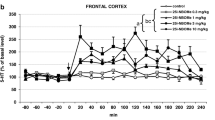Abstract
It is known that neuroglutam (at 26 mg/kg) potentiates stereotypy that is induced by the agonist of postsynaptic dopamine receptors apomorphine (1 mg/kg), and suppresses catalepsy that is induced by the blocker of postsynaptic dopamine receptors haloperidol (1 mg/kg), which points to its stimulatory influence on dopaminergic neurotransmission. Neuroglutam (26 mg/kg) does not affect the contents of noradrenaline and dopamine (DA) in homogenates of rat brain structures; however, it increases the concentration of the metabolites of dopamine 3,4-dioxyphenylacetic acid (DOPAC) in the frontal cortex and homovanillic acid (HVA) in the hippocampus, which points to its positive influence on the rate of DA utilization, and, in addition, an increase in indices that characterize the rate of DA turnover, viz., DOPAC/DA and HVA/DA in the striatum. We used the method of radioligand binding in vitro with [G-3H]-sulpiride to show that neuroglutam (10−10–10−4 M) does not directly interact with dopamine D2 receptors; however, during subchronic administration (5 days; a single daily dose of 26 mg/kg) neuroglutam promotes an increase in the density of D2 receptors in the prefrontal cortex, which points to its ability to modulate the expression of these receptors. The data from neurochemical and radioligand analysis suggest that both presynaptic (intensification of metabolic DA turnover) and postsynaptic (DA receptors) mechanisms of dopaminergic neurotransmission are involved in the neuropsychotropic action of neuroglutam. Neuroglutam did not influence the strength of hyperkinesia that was induced by the metabolic precursor of serotonin 5-hydroxytryptophan on the content of serotonin and its metabolites in rat-brain structures and did not alter the receptor binding of [G-3H]-ketanserin (an antagonist of 5-HT2A receptors) in the prefrontal cortex both under in vitro conditions and during subchronic administration ex vivo, which points to the absence of direct participation of the serotonergic system in the pharmacological action of the studied drug.
Similar content being viewed by others
References
Bagmetova, V.V., Chernysheva, Yu.V., Merkushenkova, O.V., Berestovitskaya, V.M., Vasil’eva, O.S., and Tyurenkov, I.N., Eksperimental’naya i Klinicheskaya Farmakologiya, 2013, vol. 76, no. 3, pp. 7–9.
Tyurenkov, I.N., Bagmetova, V.V., Chernysheva, Yu.V., and Yarkova, M.A., Eksperimental’naya i Klinicheskaya Farmakologiya, 2013, vol. 76, no. 11, pp. 7–12.
Mashkovskii, M.D., Seredenin, S.B., Al’tshuler, R., Vedernikov, A.A., Badyshtov, V.A., and Andreeva, N.I., Khimiko-Farmatsevticheskii Zhurnal, 1980, no. 5, pp. 7–9.
Novoselov, I.A., Cherepov, A.B., Raevskii, K.S., and Anokhin, K.V., Eksperimental’naya i Klinicheskaya Farmakologiya, 2002, vol. 65, no. 5, pp. 18–21.
Seredenin, S.B., Vestnik Rossiiskoi Akademii Meditsinskikh Nauk, 2003, no. 12, pp. 35–38.
Alexander, R.C., Wright, R., and Freed, W., Neuropsychopharmacology: Official Publication of the American College of Neuropsychopharmacology, 1996, vol. 15, no. 5, pp. 484–490.
Andreeva, N.I., Metodicheskie ukazaniya po izucheniyu antidepressantnoi aktivnosti farmakologicheskikh veshchestv. Rukovodstvo po eksperimental’nomu (doklinicheskomu) izucheniyu novykh farmakologicheskikh veshchestv (Methodical Guidance on Investigation of Antidepressant Activity of Pharmacological Substances. Manual on Experimental (Preclinical) Studies of New Pharmacological Substances), Khabriev, R.U., Ed., Moscow: OAO Izd. “Meditsina”, 2005, pp. 244–253.
Voronina, T.A. and Guzevatykh, L.S., Metodicheskie rekomendatsii po izucheniyu anal’geticheskoi aktivnosti lekarstvennykh sredstv. Rukovodstvo po provedeniyu doklinicheskikh issledovanii lekarstvennykh sredstv (Methodical Recommendations on Examination of Analgetic Activity of Medications. Manual on Performance of Preclinical Studies of Medications), Moscow: Grif i K, 2012, part 1.
Voronina, T.A., Val’dman, E.A., Nerobkova, L.N., and Kapitsa, I.G., Metodicheskie rekomendatsii po doklinicheskomu izucheniyu lekarstvennykh sredstv s protivoparkinsonicheskoi aktivnost’yu. Rukovodstvo po provedeniyu doklinicheskikh issledovanii lekarstvennykh sredstv (Methodical Recommendations on Preclinical Studies of Medications with Antiparkinson Activity. Manual on Performance of Preclinical Studies of Medications), Moscow: Grif i K, 2012, part 1.
Matveeva, M.I., Shtemberg, A.S., Timoshenko, G.N., Krasavin, E.A., Narkevich, V.B., Klodt, P.M., Kudrin, V.S., and Bazyan, A.S., Neirokhimiya, 2013, vol. 30, no. 4, pp. 343–348.
Miroshnichenko, I.I., Kudrin, V.S., and Raevskii, K.S., Farmakol. i Toksikol, 1995, vol. 51, pp. 26–29.
Leysen, J.E. and Niemegeers, C.J., Mol. Pharmacol., 1982, vol. 21, no. 2, pp. 301–14.
Sun, W., Ginovart, N., Ko, F., Seeman, P., and Kapur, S., Mol. Pharmacol., 2003, vol. 63, no. 2, pp. 456–462.
Yakimovskii, A.F., Red’ka, Yu.A., and Yakubenko, A.L., Zhurn. Vysshei Nervnoi Deyatel’nosti, 2010, vol. 60, no. 1, pp. 90–197.
Paquet, M. and Smith, Y., J. Neurosci., 2003, vol. 23, no. 20, pp. 7659–7669.
Espinoza, S., Salahpour, A., Masri, B., Sotnikova, T.D., Messa, M., Barak, L.S., Caron, M.G., and Gainetdinov, R.R., Molecular Pharmacology, 2011, vol. 80, no. 3, pp. 416–425.
Revel, F.G., Moreau, J.-L., Gainetdinov, R.R., Bradaia, A., Sotnikova, T.D., Mory, R., Durkin, S., Zbinden, K.G., Norcross, R., Meyer, C.A., Metzler, V., Chaboz, S., Ozmen, L., Trube, G., Pouzet, B., Bettler, B., Caron, M.G., Wettstein, J.G., and Hoener, M.C., PNAS, vol. 108, no. 20, pp. 8485–8490.
Xie, Z. and Miller, G.M., Journal of Pharmacology and Experimental Therapeutics, 2007, vol. 321, no. 1, pp. 128–136.
Kaluev, A.V., Neironauki, 2006, no. 2(4), pp. 29–41.
Author information
Authors and Affiliations
Corresponding author
Additional information
Original Russian Text © I.N. Tyurenkov, V.V. Bagmetova, O.V. Merkushenkova, Yu.V. Markina, P.M. Klodt, V.B. Narkevich, V.S. Kudrin, E.A. Kondrakhin, E.V. Vasil’eva, G.I. Kovalev, 2015, published in Neirokhimiya, 2015, Vol. 32, No. 1, pp. 27–36.
Rights and permissions
About this article
Cite this article
Tyurenkov, I.N., Bagmetova, V.V., Merkushenkova, O.V. et al. An analysis of the involvement of monoaminergic mechanisms in the neuropsychotropic effects of neuroglutam. Neurochem. J. 9, 20–28 (2015). https://doi.org/10.1134/S1819712415010122
Received:
Published:
Issue Date:
DOI: https://doi.org/10.1134/S1819712415010122



